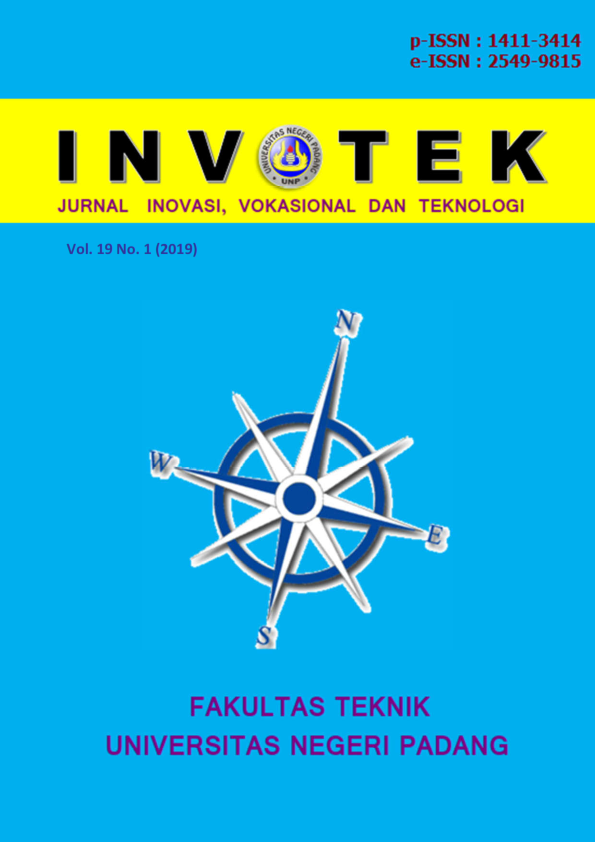Main Article Content
Abstract
Umumnya solar cell yang dipasang hanya menghadap satu arah tertentu saja. Gerak semu harian matahari menyebabkan perubahan posisi matahari dari timur ke barat setiap harinya. Perubahan posisi matahari tersebut membuat modul solar cell tidak selalu mendapatkan intensitas cahaya matahari yang maksimal sepanjang hari. Salah satu cara yang dapat dilakukan supaya solar cell mendapatkan intensitas cahaya matahari yang maksimal sepanjang hari adalah dengan menempatkan modul solar cell tegak lurus mengikuti cahaya matahari. Hal tersebut yang melatarbelakangi pembuatan alat tracking cahaya matahari menggunakan komponen Light Dependent Resistor (LDR) sebagai sensor dan motor linear aktuator parabola sebagai penggerak posisi modul solar cell. Cahaya matahari yang mengenai sensor LDR membuat resistansinya berubah sehingga mempengaruhi nilai tegangan yang akan diinformasikan ke analog input mikrokontroller. Mikrokontroller mengolah informasi yang diterima dari sensor LDR dan memberi perintah untuk menggerakkan linear aktuator yang mana akan menggerakkan posisi permukaan modul solar cell dengan dua arah yaitu mengikuti orientasi gerak semu harian matahari dari arah timur ke arah barat. Pada arah timur dan barat masing-masing terdapat sebuah limit switch. Ketika malam hari modul solar cell ini akan kembali bergerak menghadap ke arah Timur dan akan berhenti ketika limit switch Timur aktif. Alat tracking cahaya matahari ini telah dilakukan uji coba. Alat ini telah dapat mengikuti pergerakan matahari dari timur ke barat dengan daya keluaran solar cell dari 8,71 watt mampu ditingkatkan menjadi 12,46 watt dengan konsumsi daya motor sebesar 2,08 watt.
Keywords
Article Details

This work is licensed under a Creative Commons Attribution 4.0 International License.
Copyright (c): Dwiprima Elvanny Myori, Riki Mukha, Erna Fitri (2019)References
- [1] Bishop, O. (2004). Dasar-dasar Elektronika. Jakarta: Erlangga.
- [2] Dhanabal. R. et al. (2013). Comparison of Efficiencies of Solar Tracker systems with static panel Single-Axis Tracking System and Dual-Axis Tracking System with Fixed Mount. International Journal of Engineering and Technology (IJET), Vol. 5 No. 2 Apr-may 2013.
- [3] Hersch, P., & Zweibel, K. (1982). Basic Photovoltaic Principles and Methods. Colorado: Solar Energy Research Institite.
- [4] Kadir, A. (2013). Panduan Praktis mempelajari Aplikasi Mikrokontroller dan Pemrogramannya Menggunakan Arduino. Yogyakarta: Andi.
- [5] Luque, A., & Hegedus, S. (2003). Hand Book of Photovoltaic Science and Engineering. England: John Wiley & Sons Ltd.
- [6] Markvart, T. (2000). Solar Electricity. England: Jonh Wiley & Sons Ltd.
- [7] Mostavan, A. (2000). Catatan Kuliah Energi Surya. Bandung: ITB.
- [8] Partain, L. D. (1995). Solar Cells and Their Applications. New York: A Wiley-Interscience Publication.
- [9] Prinsloo, G., & Dobson, R. (2015). Solar Tracking. South Africa: Stellenbosch University.
- [10] Rachmat, C. A. (2010). Algoritma Dan Pemrograman dengan Bahasa C. Andi: Yogyakarta.
- [11] Satwiko. (2012, 25 12). HFI-DIY Jateng. Diambil kembali dari http://hfi-diyjateng.or.id/makalah/uji-karakteristik-sel-surya-pada-sistem-24-volt-dc-sebagai-catudaya-pada-sistem-pembangkit
- [12] Suryana, D. (2016). Otomasi Pada Panel Surya Menggunakan Sistem Tracking aktif tipe Single-Axis. Widyariset (Vol.2 No.1), 27-36.
- [13] Syahwil, M. (2013). Panduan Mudah Simulasi dan Praktik Mikrokontroller Arduino. Yogyakarta: Andi.
- [14] Tudorache, T., & Kreindler, L. (2010). Design of a Solar Tracker System for PV Power Plants. Acta Polytechnica Hungarica, Volume 7, Number 1.
- [15] Yuwono, B. (2005). Optimalisasi Panel Sel Surya dengan menggunakan Sistem Pelacak Berbasis Mikrokontroller AT89C51. Surakarta: Universitas sebelas Maret.
- [16] Zuhal. (2000). Dasar Teknik Listrik dan Elektronika Daya. Jakarta: Gramedia Pustaka Utama.
